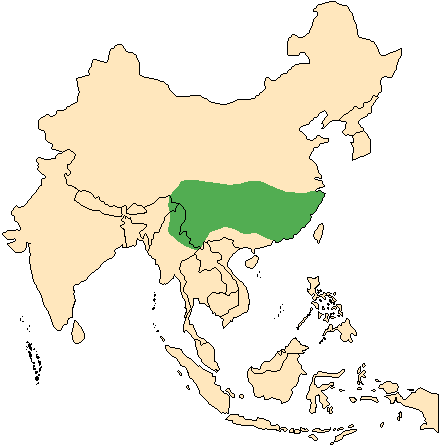![]() Return
to Artiodactyla
Return
to Artiodactyla
Classification
|
 Elaphodus
cephalophus
Elaphodus
cephalophus
Tufted deer
![]()
Taxonomy
 |
 |
 |
Click on the pictures above for a larger view of the
photographs
|
||
General Characteristics
Body Length: 110-160 cm / 3.6-5.3 ft.
Shoulder Height: 50-70 cm / 1.6-2.3 ft.
Tail Length: 7-16 cm / 2.8-6.4 in.
Weight: 17-50 kg / 37-110 lb.The coarse coat is made up of spine-like hairs, and is generally dark grey to chocolate brown. The head and neck are grey. The tuft on the forehead is blackish brown and may grow 17 cm / 7 inches long. The lips, the tips of the ears, and the underside of the tail are all startlingly white. In addition, some animals have a pale streak running around the eye and upward towards the ears. The simple spiked antlers, borne only by males, grow from short, bony pedestals on the forehead. A more visible characteristic in males, however, is the length of the upper caniness, which may grow up to 2.5 cm / 1 inch long, and protrude from the mouth like fangs. Young are coloured like adults with the additionof a row of white spots along each side of the spine.
Ontogeny and Reproduction
Gestation Period: 180 days.
Young per Birth: 1, rarely 2.
Sexual Maturity: At 18 months.Mating happens in late fall and early winter, with the subsequent births occurring in the early summer.
Ecology and Behavior
The tufted deer is a crepuscular animal, most active at dawn and dusk. When fleeing, the tufted deer holds its tail up revealing the white underside, much like the white-tailed deer. The tail flops down with every cat-like bounce, making the deer's progress difficult to follow. Tufted deer are territorial, and rarely leave their home range, which is criss-crossed by a network of trails. Both sexes bark when alarmed, like their relatives, the muntjacs, but due to their colouration, are very difficult to spot. Barking is also used in the breeding season for locating and communicating with partners.Family group: Usually solitary, although occasionally travelling in pairs.
Diet: Grasses, sprouts, carrion.
Main Predators: Leopard, dhole.
Distribution
Mountain forests at elevations of 300-4,500 meters / 1,000-15,000 feet in western China and northern India and Burma.

Range Map (Redrawn from Whitehead, 1993)
Conservation Status
The current status of the tufted deer, including all subspecies, is unknown, due to a lack in data.
Remarks
The name refers to the tuft of hair on this small deer's forehead, which often hides the dainty antlers. Elaphos (Greek) a deer; odous (Greek) a tooth: referring to the large upper canines of the male. Kephale (Greek) the head; lophos (Greek) a crest; the male has a crest of hair on the forehead and around the base of the antlers.
Literature Cited
Kurt, F. 1990. Muntjac deer. In Grzimek's Encyclopedia of Mammals. Edited by S. P. Parker. New York: McGraw-Hill. pp. 137-139.Nowak, R. M. [editor]. 1991. Walker's Mammals of the World (Fifth Edition). Baltimore: The Johns Hopkins University Press.
Whitehead, K. G. 1993. The Whitehead Encyclopedia of Deer. Stillwater, MN: Voyageur Press, Inc.
Wilson, D. E., and D. M. Reeder [editors]. 1993. Mammal Species of the World (Second Edition). Washington: Smithsonian Institution Press. Available online at http://nmnhwww.si.edu/msw/
Return to Artiodactyla

![]()
© Brent Huffman, www.ultimateungulate.com |
|
|